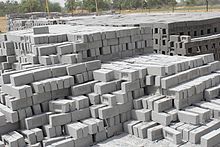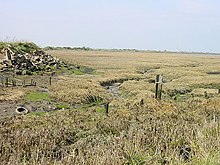Fly ash brick
Compressed at 28 MPa (272 atm) and cured for 24 hours in a 66 °C steam bath, then toughened with an air entrainment agent, the bricks can last for more than 100 freeze-thaw cycles.
In this case, the ground clay escapes along with flue gases, settling as ash in bag filters or electro static precipitators (ESPs).
Main ingredients include fly ash, water, quicklime or lime sludge, cement, aluminum powder and gypsum.
The chemical reaction[further explanation needed] due to the aluminum paste provides AAC its distinct porous structure, lightness, and insulating properties.
Using these blocks in buildings reduces the dead load, allowing one to save around 30 to 35%[citation needed] of structural steel, and concrete.
In the cement route, the composition is fly ash (76%), OPC (20%), and anhydrite (4%), to which 3 to 4 times as much filler material can be added.

